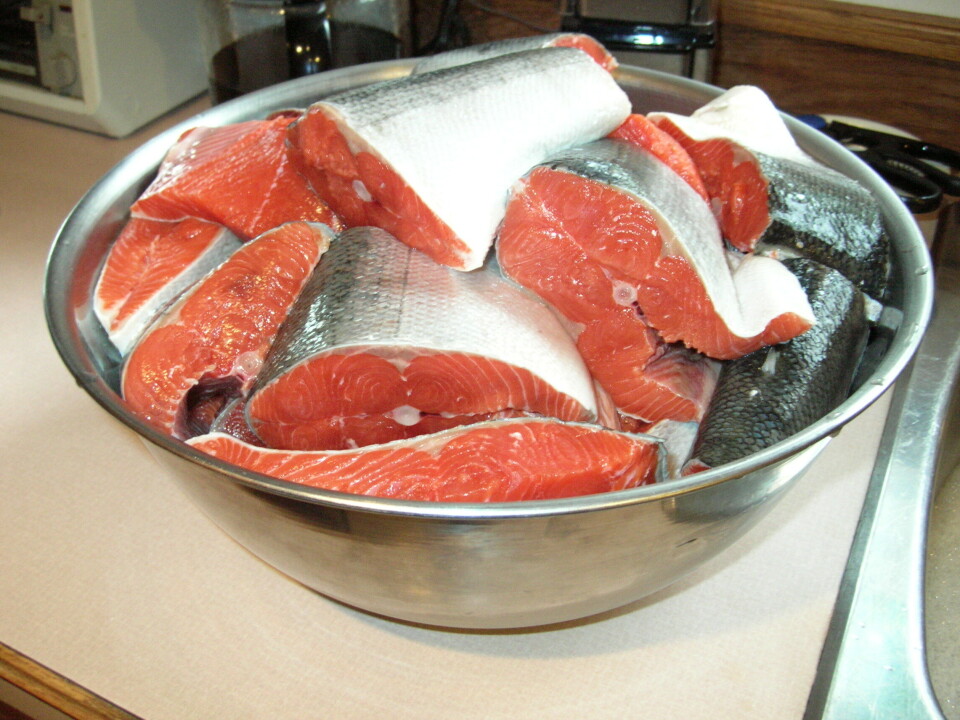
Farmed salmon not “dyed”
For years many environmental groups and others in Canada and elsewhere have perpetuated a notion that somehow farmed salmon get their flesh colour from some form of “dye”. A typical example of this is found in the Vancouver-based David Suzuki Foundation’s brochure “Salmon Aquaculture”, which states; “Chemical dyes are also administered to farmed salmon to colour their flesh which would otherwise be grey”. The fact is that both wild and farmed salmon both get their pink/red flesh colour from the same source- carotenoids. The only difference is that this essential nutrient that is used for farmed salmon comes from a number of different sources, as Mike Mitchell from Clean Fish explains;
We’ve all heard that farmed salmon is “dyed” and without the dye, farmed salmon would be an off-white color, not the vibrant reddish orange of most salmon. But what’s the real story behind this? Astaxanthin is the carotenoid responsible for salmon’s reddish hue. This fat-soluble pigment is only manufactured by plants and algae and works its way into salmon through diet, including krill and shrimp. Astaxanthin is also responsible for the pigmentation of crustaceans like crabs and lobsters and even flamingos! In fact, without a steady supply of astaxanthin through their diets, wild Pacific salmon are also off-white instead of red-orange. The ivory king salmon and marbled salmon are actually wild salmon with genetic defects that prevent their bodies from affixing astaxanthin. About 1 in 100... wild king salmon are ivory, with their own distinct flavour and texture. Ivory salmon have a silkier, buttery flavour and often command higher prices than typical salmon. In addition to the red-orange pigmentation, astaxanthin provides vital health benefits to salmon. Astaxanthin has 100-500 times the anti-oxidant capacity of vitamin E and prevents peroxidation or degradation of fat cells, which is crucial in protecting cold-water species like salmon. Astaxanthin also helps with fertilization, cellular respiration and immune system functions. Because of its strong antioxidant properties, astaxanthin is commonly used as a nutritional supplement for humans. The irony is that astaxanthin capsules are sold at many of the same stores that frown upon farmed salmon specifically because of its color-added stipulation! At a recent visit to a San Francisco high-end food store, the fishmonger told me he only sells wild salmon because no one was buying the color-added farmed salmon. Additionally, he didn’t even know how color was actually added to the salmon. However, at the same store, multiple varieties of astaxanthin supplements were being sold. For humans, astaxanthin provides potent anti-inflammatory benefits and is crucial for people with cardiovascular diseases, cancer and arthritis. Astaxanthin has even been proven to prevent the formation of cataracts. In fact, on a recent Dr. Oz episode, astaxanthin was touted as “The Number 1 supplement you’ve never heard of that you should be taking.” Since farmed salmon are not fed steady diets of krill and shrimp, synthetic astaxanthin is added to their feed. Synthetic astaxanthin was created in the 1950s as a substitute for harvesting vast amounts of wild krill. At the time, the inventors applied for FDA approval as a color additive instead of a nutritional supplement which today has created the controversial “color-added” topic, although farmed salmon need astaxanthin to be healthy. This issue has been the go-to complaint for opponents of farmed salmon, although the “dyes” that opponents refer to are the same substances found in wild salmon. Today scientists are working on natural alternatives to synthetic astaxanthin. Phaffia yeast has been proven to be a reliable source of astaxanthin, but is prohibitively costly. Additionally, astaxanthin can be manufactured from shrimp processing waste. Though an innovative use of waste products, the yield is quite low – 12,000 lbs of shrimp shells yields only 6-8 gallons of astaxanthin oil. A recent development, Panaferd, is quickly becoming the most viable alternative to synthetic astaxanthin. Made from soil-dwelling bacteria that naturally contain astaxanthin, Panaferd is now being used at Loch Duart farms. Says managing director Nick Joy: “We believe that this is the closest thing that we can find to what a salmon would naturally encounter in the wild, and we herald this as an important step forward.” So next time you hear someone disparaging farmed salmon as dyed, remember that color-added should really be “health-supplement added.” Astaxanthin is added to salmon feed to replicate the krill that wild salmon eat, not specifically to add color to the fish. Salmon need astaxanthin to be healthy, and so do you.























































